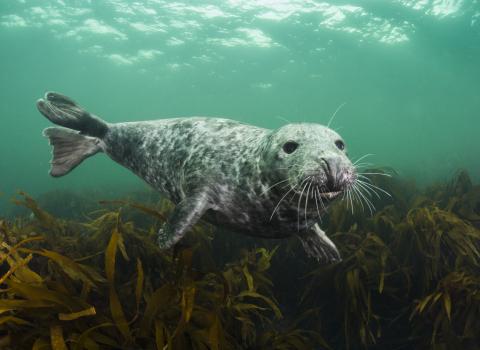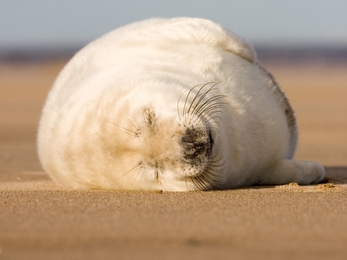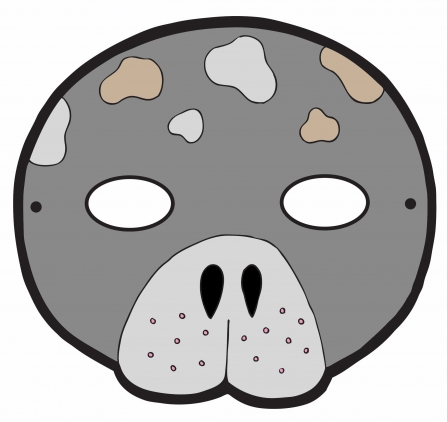All you need to know about grey seals in Lincolnshire
The British population of grey seals is of great international importance and we are fortunate to have a thriving colony on the Lincolnshire coast.
Grey seals have been breeding on the Lincolnshire coast since the early 1970s. For much of the year the seals are at sea or hauled out on distant sandbanks but during the winter they come to breed and give birth on the beaches of Lincolnshire.
Pups are born with white coats and suckle from their mother for about two to three weeks. The mother will then leave the pup to mate again before leaving the beach. The weaned pup sheds its white coat and after a while, hunger drives it to make its way to the sea to look for its own food.
Did you know...
- Sand eels, cod, lobster and crab are a seals favourite foods
- Between tides, seals will haul themselves out of the water onto rocks or sandy islands; these are called haul-outs
- Grey seals were the first mammals to be protected by modern legislation – the Grey Seals Protection Act, 1914
- Male grey seals are called bulls, female seals are called cows
- Grey seals have super sensitive whiskers, known as mystacial vibrissae, to detect moving fish when hunting in poor visibility
- Killer whales (and humans) are a grey seals only predator in British seas
- Grey seals belong to the Order pinnipedia, which includes seals, sea lions and walruses. Pinniped translates to mean 'feather-footed'
- Young seal pups are covered in white fur when they're born
- After giving birth, female seals will remain with their pup for about three weeks and will not go back to the sea to feed themselves. She will lose about a quarter of her body weight during this time
- Three to four weeks after giving birth to their pups, the mothers will mate again and return the following year to start the cycle again
Statistics
- Grey seal pups weigh about 14kg at birth
- Males can weigh up to 300kg and females around 200kg. They will consume between four to six percent of their body weight in food per day. For the males, that's about 15kg of fish every day!
- A female's milk contains up to 60% fat, helping the seal pup to gain about 2kg in weight every day
- Their flippers are about 25cm long
- Female grey seals may live for 35 years, but males seldom survive to more than 25 years old
- A seals blubber is about as thick as the length of your middle finger!
- About 40% of the world's population of seals can be found in Britain, 90% of which breed in Scotland
Common seals
How to tell a common seal from a grey seal
- Grey seals have parallel nostrils, whereas common seals have v-shaped nostrils
- Grey seals have an elongated head/snout, whereas common seals have small, rounded head
- Grey seals mate on land, whereas common seals tend to breed in the water or at haul-outs - the pups are very well developed after birth and will swim and dive at just a couple of hours old
- Common seals are smaller, weighing up to 130kg compared to a grey seal whose males can weigh over 200kg
- The common seal is in fact less common in British waters than the grey seal
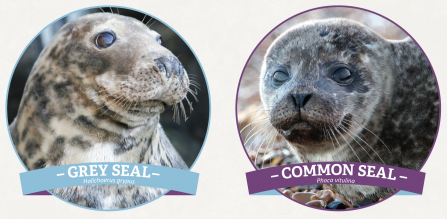
Grey seal - Mike Snellle, Common seal - Jim Higham
Fun fact
A grey seals scientific name is Halichoerus grypus, which literally translates to mean hook-nosed sea pig!
Threats
Seal pups grow very quickly but there are many dangers for a young pup. These include:
- Starvation - if there is a lot of disturbance from humans and dogs the mother seal will not return to the pup often enough to feed it
- Abandoning - if the mother seal is severely concerned due to disturbance or if she is inexperienced she may leave the pup, without regular feeding the pup will die in three or four days
- Infection - young pups are very prone to infection, especially to the eyes and respiratory tract
- Drowning - can happen on the large spring tides or if the pup is disturbed and frightened into the water
How you can help
If you should find a small seal pup on the beach, do not approach too closely, keep your dog on a lead and certainly never attempt to handle a seal – they can give a very serious bite and a mother may abandon a pup that smells of humans or dogs.
If you are concerned about the welfare of a seal on a Lincolnshire beach, please contact a local seal/animal hospital such as those at Skegness or Mablethorpe.
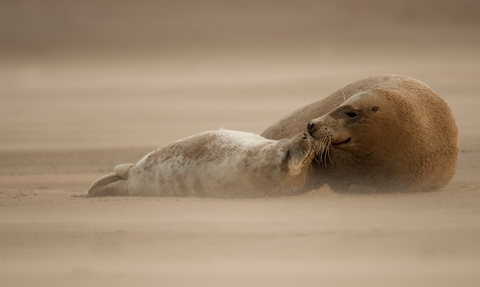
Danny Green/2020VISION
Donate to our Seal Appeal
- BBC Nature (http://www.bbc.co.uk/nature/life/Gray_Seal)
- The Mammal Society (http://www.mammal.org.uk/?s=seal)
- Discover Wildlife (http://www.discoverwildlife.com/british-wildlife/how-identify-british-seals)
- NOAA (http://www.nmfs.noaa.gov/pr/species/mammals/seals/gray-seal.html)
- ABPmer (http://www.abpmer.co.uk/buzz/10-things-you-might-not-know-about-grey-seals/)

